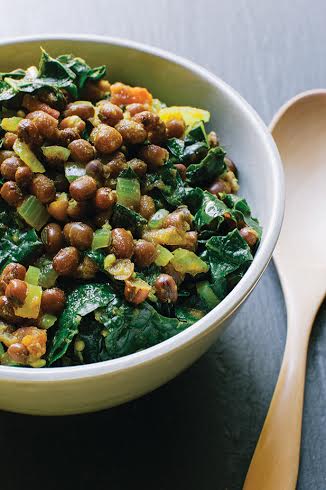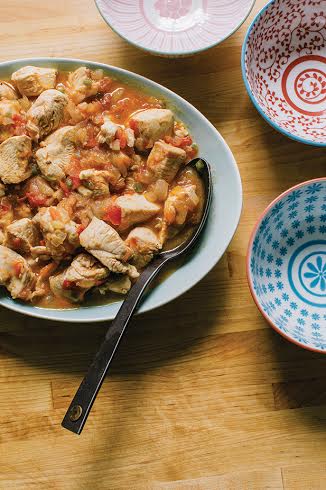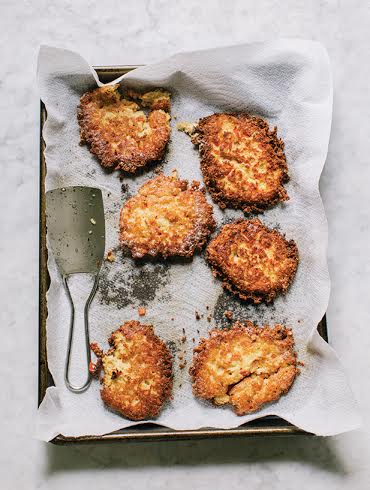Uttapam (South Indian Savory Pancake)
Uttapams are a staple of South Indian fare, and are often referred to as an Indian pizza because they are flat and savory. You can top them with vegetables, chicken, chutneys, or simply enjoy them plain. These SCD-style uttapams are a delicious addition to your international meal planning.
Ingredients:
2 eggs
5 tablespoons (75 mL) water
1/2 teaspoon (2.5 mL) lemon juice
1/4 teaspoon Homemade Curry Powder (p. 347)
1/8 teaspoon chili powder
1 tablespoon fresh cilantro, chopped fine
1 teaspoon fresh garlic, peeled and grated
4 tablespoons (40 g) onion, peeled and grated
1/2 cup (75 g) red bell pepper, seeded and chopped fine
1 cup (110 g) almond flour
oil for frying
Instructions:
In a mixing bowl, combine the egg, water, and lemon juice together with the curry and chili powders, and fresh cilantro. Once these are blended, add in the garlic, onions, and red bell pepper. Finally, mix in the almond flour. Use a whisk or mixing spatula to blend it well by hand–the batter should be airy. Set aside.
In the meanwhile, heat a skillet on the stovetop and allow oil to be fairly hot. Be generous about oil for cooking, as the uttapams need to be able to be flipped easily, and not get stuck to the pan or burnt.
Spoon uttapam batter to stovetop pan – about four 3-inch circles in every batch–and allow one side to cook completely (should be golden brown) before flipping over to cook the other side.
Remove the uttapams and allow them to cool. Repeat process until all batter is used up.
Yield:
12-15 mini-uttapam circles
Zahra’s Chicken Curry
In our family, we always have our challenges around the dinner table with a push and pull situation: “Eat your veggies,†“Finish your chicken,†“less treats and more food,†and so on. So we were very pleased when after an extended trip to Bombay, our daughter Zahra proclaimed that Chicken Curry was her “favorite dish in the whole world.â€
Ingredients:
1 1/2 pounds (660 g) boneless, skinless chicken breasts, diced into 1-inch cubes
3 tablespoons (45 mL) olive oil
1 teaspoon garlic, peeled and minced fine
1 teaspoon ginger, peeled and grated
1 medium onion, peeled and chopped fine
1 teaspoon coriander powder
1 teaspoon cumin powder
1/2 teaspoon turmeric powder
2 tomatoes, chopped fine
1 medium jalapeño chili, seeded and chopped fine
salt and black pepper to taste
Instructions:
Pierce chicken with a fork or sharp knife for marinating purposes. Marinate chicken in 1 tablespoon of olive oil, with the garlic, ginger, salt and black pepper. Set aside for 30 minutes.
In the meantime, in a stovetop skillet, heat 2 tablespoons of remaining olive oil in pan and sauté onions over medium heat. Add in the coriander, cumin, and turmeric powders, and stir quickly. To make sure spices do not burn, immediately add in the tomatoes and jalapeño chili. Stir slowly until tomatoes are well blended and mixture has a spicy flavor.
Finally, add in the chicken pieces, and cook until done, approximately 20-30 minutes.
Yield:
4-6 servings
Rajma (Red Lentil) & Kale Curry
Dal is a staple across India from sprawling urban metropolises to tiny villages. Although the SCD does not allow for the staple bean of Indian lentils to be used, we used the maroon adzuki beans to create a tasty curry, which has the addition of leafy kale in it. You do not have to feel like an outsider at your neighborhood Indian restaurant, just bring your own tiffin along with you!
Ingredients:
2 1/2 tablespoons (37 mL) olive oil
1/2 teaspoon fresh ginger, peeled and chopped fine
3 cloves garlic, peeled and chopped fine
1 onion, peeled and chopped fine
2 tomatoes, chopped
1 teaspoon turmeric powder
1/2 teaspoon chili powder
1 teaspoon cumin powder
1/2 teaspoon coriander powder
1 teaspoon mustard seeds*
1 cup (220 g) pre-cooked red adzuki beans**
4 cups (268 g) fresh kale leaves, chopped
1/4 cup (60 mL) water
Instructions:
To make the curry, in a stovetop pan, heat the olive oil, and add in the ginger, garlic, onion, and tomatoes. Then sprinkle in all the spices: the turmeric, chili, cumin, coriander powders, and mustard seeds. If the resultant mixture is too dry, add some water (approximately 1/4 cup).
Lastly add in the pre-cooked adzuki beans and kale leaves. Stir in, and simmer until cooked through, another 20-30 minutes or so. Make sure the pan is covered so that curry does not dry out.
Yield:
3-4 servings
*Pre-cooking the beans: To prepare the beans, soak them in a large pot of water overnight, or for about 12 hours. Drain and rinse the beans under running water. Refill the pot with fresh batch of water, and set over medium heat. Simmer the beans for about 1 1/2 to 2 hours, or until they are soft and cooked through (but not mushy). Once they are done, drain them and set aside.
*Note: Wait for at least 3 months after symptoms have cleared to try any kind of seeds and beans.
Indian Lemonade
This unusual twist to lemonade has been imported from India. The use of the cumin creates an additional tanginess to the sourness of the lemons. Feel free to add more honey if you want it sweeter.
Ingredients:
2 1/2 tablespoons (50 g) honey
6 cups (1.4 L) water
1/2 teaspoon cumin powder
3 limes, juiced
Instructions:
Warm the honey over the stovetop in a small saucepan, in 1/2 cup of the water so that it is dissolved in. Pour the remaining 5 1/2 cups of water into a pitcher, and add in the cumin and lime juice. Add in the warmed honey to the pitcher and mix well.
Serve chilled with ice, or at room temperature.
Yield:
6 cups (1.4 L)
ABOUT THIS BOOK:
This groundbreaking book serves as a comprehensive guide for the Dairy-Free version of the Specific Carbohydrate DietTM (SCD-DF). The original SCD (a grain-free, sugar-free, soy-free diet), introduced by Elaine Gottschall in Breaking the Vicious Cycle, has been further
researched and developed into the SCD-DF in order to help people with autism and ADHD.
The SCD for Autism and ADHD draws on over a decade of a nurse’s clinical experience with the SCD-DF (Pamela Ferro) and written in collaboration with an established SCD author
(Raman Prasad). The first part of the book explains the scientific research that supports the Specific Carbohydrate Diet – Dairy Free dietary intervention. It describes how conditions –from anxiety and eczema to reflux and motor coordination – are also tied to autism and
ADHD. It guides families on how to start the SCD-DF – from building a support network and setting up the kitchen – to shopping lists, meal plans, and what to expect on the first days of the diet.







